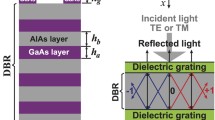Abstract
We propose and demonstrate a method to characterize waveguide loss using the spectral response of combinations of distributed Bragg reflectors. The method is independent of coupling efficiency and waveguide dispersion and does not require the introduction of bending loss into the device.




Similar content being viewed by others
References
D. Marcuse, Bell Sys. Tech. J. 48, 3187–3215 (1969)
F.P. Payne, J.P.R. Lacey, Opt. Quant. Electron. 26, 977–986 (1994)
G.P. Agrawal, Nonlinear Fiber Optics, 4th edn. (Academic Press, New York, 2003)
P. Dong, W. Qian, S. Liao, H. Liang, C.-.C. Kung, N.-.N. Feng, R. Shafiiha, J. Fong, D. Feng, A.V. Krishnamoorthy, M. Asghari, Opt. Express 18, 14474–14479 (2010)
M. Heiblum, IEEE J. Quantum Electron. QE-11, 75–83 (1975)
D.M. Shyroki, IEEE Trans. Microwave Theory Tech. 56, 414–419 (2008)
A. Yariv, Electron. Lett. 4, 321–322 (2000)
W.R. McKinnon, D.-X. Xu, C. Storey, E. Post, A. Densmore, A. Delâge, P. Waldron, J.H. Schmidt, S. Janz, Opt. Express 17, 18971–18982 (2009)
Y. Painchaud, M. Poulin, C. Latrasse, M.-J. Picard, Bragg grating based Fabry-Perot filters for characterizing silicon-on-insulator waveguides. Paper presented at the IEEE 9th international conference on group IV photonics (GFP), San Diego, California, USA, 29–31 Aug. (2012)
A. Yariv, P. Yeh, Optical Waves in Crystals: Propagation and Control of Laser Radiation (Wiley, Hoboken, New Jersey 2003), Chap. 11
P. Yeh, Optical Waves in Layered Media (Wiley, Hoboken, New Jersey 2005), Chap. 6
H.-C. Kim, K. Ikeda, Y. Fainman, J. Lightw. Technol. 25, 1147–1151 (2007)
J.R. Taylor, An Introduction to Error Analysis: The Study of Uncertainties in Physical Measurements (University Science Books, Sausalito, California 1997)
Acknowledgments
This work was supported by the National Science Foundation (NSF), the NSF Engineering Research Center for Integrated Access Networks, Defense Advanced Research Projects Agency, and the Cymer Corporation. The authors would like to thank the Nano3 staff at UCSD for support during sample fabrication, and C. Hennessey for logistical support.
Author information
Authors and Affiliations
Corresponding author
Appendix: Derivations
Appendix: Derivations
1.1 Coefficients of transmission and reflection of a DBR
We shall take as our starting point Eqs. (1, 3) of the paper. To uncouple the equations, first differentiate them:
Complete the decoupling by substitution from Eqs. (1, 3) in order to obtain separate differential equations for the forward and backward propagating field amplitudes:
The general solution of Eqs. (25, 26) is Eqs. (4–6) of the paper.
The boundary conditions that we will apply to determine the undetermined coefficients C 1, C 2, D 1, and D 2 in Eqs. (4–6) are A B (L DBR) = 0 and A F (0) = a nonzero constant. This corresponds to the physical arrangement in which only a forward propagating field is incident upon the DBR. It is possible to eliminate two of the coefficients by substituting the boundary conditions into Eqs. (4, 5). The general solutions may then be rewritten as:
Substituting Eqs. (27, 28) into Eqs. (1, 2) and again employing the boundary conditions, the remaining coefficients may be determined:
The coefficients of reflection and transmission may be determined by substituting Eqs. (29, 30) into Eqs. (27, 28):
where r F is the coefficient of reflection and t F is the coefficient of transmission. It is trivial to manipulate Eqs. (31, 32) into Eqs. (7, 8).
1.2 First-order approximation of null point coefficient of reflection
To arrive at the null point reflectance to first order in α DBR, begin by considering the parameter s described by Eq. (6) at the null point Δβ null described by Eq. (10). Neglecting the term that is second order in α DBR, the product s·L DBR at such a point becomes:
Next, take the Taylor series of the radical in Eq. (33) and keep the terms to first order in α DBR:
Next use the approximation in Eq. (34) to simplify the term in the denominator of coefficient of reflectance Eq. (7) containing the hyperbolic tangent:
Taking the hyperbolic tangent to first order and substituting in Eq. (10), Eq. (35) becomes:
Substituting Eqs. (36) and (10) into Eq. (6) and keeping only terms of the first order in α DBR results in the expression for reflectance:
It is trivial to verify that taking the magnitude of Eq. (37) results in Eq. (11).
Rights and permissions
About this article
Cite this article
Grieco, A., Slutsky, B. & Fainman, Y. Characterization of waveguide loss using distributed Bragg reflectors. Appl. Phys. B 114, 467–474 (2014). https://doi.org/10.1007/s00340-013-5543-x
Received:
Accepted:
Published:
Issue Date:
DOI: https://doi.org/10.1007/s00340-013-5543-x



